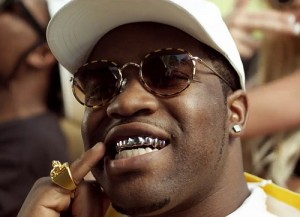Buckle up, everyone; this post is going to be a long one. Today, I wanted to discuss the matter of conspicuous consumption: the art of spending relatively large sums of money on luxury goods. When you see people spending close to $600 on a single button-up shirt, two-months salary on engagement rings, or tossing spinning rims on their car, you’re seeing examples of conspicuous consumption. A natural question that many people might (and do) ask when confronted with such outrageous behavior is, “why do you people seem to (apparently) waste money?” A second, related question that might be asked once we have an answer to the first question (indeed, our examination of this second question should be guided by – and eventually inform – our answer to the first) is how can we understand who is most likely to spend money in a conspicuous fashion? Alternatively, this question could be framed by asking about what contexts tend to favor conspicuous consuming behavior. Such information should be valuable to anyone looking to encourage or target big-ticket spending or spenders or, if you’re a bit strange, you could also try to create contexts in which people spend their money more responsibly.
But how fun is sustainability when you could be buying expensive teeth instead?
The first question – why do people conspicuously consume – is perhaps the easier question to initially answer, as it’s been discussed for the last several decades. In the biological world, when you observe seemingly gaudy ornaments that are costly to grow and maintain – peacock feathers being the go-to example – the key to understanding their existence is to examine their communicative function (Zahavi, 1975). Such ornaments are typically a detriment to an organism’s survival; peacocks could do much better for themselves if they didn’t have to waste time and energy growing the tail feathers which make it harder to maneuver in the world and escape from predators. Indeed, if there was some kind of survival benefit to those long, colorful tail feathers, we would expect that both sexes would develop them; not just the males.
However, it is because these feathers are costly that they are useful signals, since males in relatively poor condition could not shoulder their costs effectively. It takes a healthy, well-developed male to be able to survive and thrive in spite of carrying these trains of feathers. The costs of these feathers, in other words, ensures their honesty, in the biological sense of the word. Accordingly, females who prefer males with these gaudy tails can be more assured that their mate is of good genetic quality, likely leading to offspring well-suited to survive and eventually reproduce themselves. On the other hand, if such tails were free to grow and develop – that is, if they did not reliably carry much cost – they would not make good cues for such underlying qualities. Essentially, a free tail would be a form of biological cheap talk. It’s easy for me to just say I’m the best boxer in the world, which is why you probably shouldn’t believe such boasts until you’ve actually seen me perform in the ring.
Costly displays, then, owe their existence to the honesty they impart on a signal. Human consumption patterns should be expected to follow a similar pattern: if someone is looking to communicate information to others, costlier communications should be viewed as more credible than cheap ones. To understand conspicuous consumption we would need to begin by thinking about matters such as what signal someone is trying to send to others, how that signal is being sent, and what conditions tend to make the sending of particular signals more likely? Towards that end, I was recently sent an interesting paper examining how patterns of conspicuous consumption vary among racial groups: specifically, the paper examined racial patterns of spending on what was dubbed visible goods: objects which are conspicuous in anonymous interactions and portable, such as jewelry, clothing, and cars. These are good designed to be luxury items which others will frequently see, relative to other, less-visible luxury items, such as hot tubs or fancy bed sheets.
That is, unless you just have to show off your new queen mattress
The paper, by Charles et al (2008), examined data drawn from approximately 50,000 households across the US, representing about 37,000 White 7,000 Black, and 5,000 Hispanic households between the ages of 18 and 50. In absolute dollar amounts, Black and Hispanic households tended to spend less on all manner of things than Whites (about 40% and 25%, respectively), but this difference needs to be viewed with respect to each group’s relative income. After all, richer people tend to spend more than poorer people. Accordingly, the income of these households was estimated through their reports of their overall reported spending on a variety of different goods, such as food, housing, etc. Once a household’s overall income was controlled for, a better picture of their relative spending on a number of different categories emerged. Specifically, it was found that Blacks and Hispanics tended to spend more on visible goods (like clothing, cars, and jewelry) than Whites by about 20-30%, depending on the estimate, while consuming relatively less in other categories like healthcare and education.
This visible consumption is appreciable in absolute size, as well. The average white household was spending approximately $7,000 on such purchases each year, which would imply that a comparably-wealthy Black or Hispanic household would spend approximately $9,000 on such purchases. These purchases come at the expense of all other categories as well (which should be expected, as the money has to come from somewhere), meaning that the money spent on visible goods often means less is spent on education, health care, and entertainment.
There are some other interesting findings to mention. One – which I find rather notable, but the authors don’t see to spend any time discussing – is that racial differences in consumption of visible goods declines sharply with age: specifically, the Black-White gap in visible spending was 30% in the 18-34 group, 23% in the 35-49 group, and only 15% in the 50+ group. Another similarly-undiscussed finding is that visible consumption gap appears to decline as one goes from single to married. The numbers Charles et al (2009) mention estimate that the average percentage of budgets used on visible purchases was 32% higher for single Black men, 28% higher for single Black women, and 22% higher for married Black couples, relative to their White counterparts. Whether these declines represent declines in absolute dollar amounts or just declines in racial differences, I can’t say, but my guess is that it represents both. Getting old and getting into relationships tended to reduce the racial divide in visible good consumption.
Cool really does have a cut-off age…
Noting these findings is one thing; explaining them is another, and arguably the thing we’re more interested in doing. The explanation offered by Charles et al (2009) goes roughly as follows: people have a certain preference for social status, specifically with respect to their economic standing. People are interested in signaling their economic standing to others via conspicuous consumption. However, the degree to which you have to signal depends strongly on the reference group to which you belong. For example, if Black people have a lower average income than Whites, then people might tend to assume that a Black person has a lower economic standing. To overcome this assumption, then, Black individuals should be particularly motivated to signal that they do not, in fact, have a lower economic standing more typical of their group. In brief: as the average income of a group drops, those with money should be particularly inclined to signal that they are not as poor as other people below them in their group.
In support of this idea, Charles et al (2008) further analyzed their data, finding that the average spending on visible luxury goods declined in states with higher average incomes, just as it also declined among racial groups with higher average incomes. In other words, raising the average income of a racial group within a state tended to strongly impact what percentage of consumption was visible in nature. Indeed, the size of this effect was such that, controlling for the average income of a race within a state, the racial gaps almost entirely disappeared.
Now there are a few things to say about this explanation, first of which being that it’s incomplete as stands. From my reading of it, it’s a bit unclear to me how the explanation works for the current data. Specifically, it would seem to posit that people are looking to signal that they are wealthier than those immediately below them in the social ladder. This could explain the signaling in general, but not the racial divide. To explain the racial divide, you need to add something else; perhaps that people are trying to signal to members of higher income groups that, though one is a member of a lower income group, one’s income is higher than the average income. However, that explanation would not explain the age/marital status information I mentioned before without adding on other assumption, nor would directly explain the benefits which arise from signaling one’s economic status in the first place. Moreover, if I’m understanding the results properly, it wouldn’t directly explain why visible consumption drops as the overall level of wealth increases. If people are trying to signal something about their relative wealth, increasing the aggregate wealth shouldn’t have much of an impact, as “rich” and “poor” are relative terms.
“Oh sure, he might be rich, but I’m super rich; don’t lump us together”
So how might this explanation be altered to fit the data better? The first step is to be more explicit about why people might want to signal their economic status to others in the first place. Typically, the answer to this question hinges on the fact that being able to command more resources effectively makes one a more valuable associate. The world is full of people who need things – like food and shelter – so being able to provide those things should make one seem like a better ally to have. For much the same reason, being in command of resources also tends to make one appear to be a more desirable mate as well. A healthy portion of conspicuous signaling, as I mentioned initially, has to do with attracting sexual partners. If you know that I am capable of providing you with valuable resources you desire, this should, all else being equal, make me look like a more attractive friend or mate, depending on your sexual preferences.
However, recognition of that underlying logic helps make a corollary point: the added value that I can bring you, owing to my command of resources, diminishes as overall wealth increases. To place it in an easy example, there’s a big difference between having access to no food and some food; there’s less of a difference between having access to some food and good food; there’s less of a difference still between good food and great food. The same holds for all manner of other resources. As the marginal value of resources decreases as access to resources increases overall, we can explain the finding that increases in average group wealth decrease relative spending on visible goods: there’s less of a value in signaling that one is wealthier than another if that wealth difference isn’t going to amount to the same degree of marginal benefit.
So, provided that wealth has a higher marginal value in poorer communities – like Black and Hispanic ones, relative to Whites – we should expect more signaling of it in those contexts. This logic could explain the racial gap on spending patterns. It’s not that people are trying to avoid a negative association with a poor reference group as much as they’re only engaging in signaling to the extent that signaling holds value to others. In other words, it’s not about my signaling to avoid being thought of as poor; it’s about my signaling to demonstrate that I hold a high value as a partner, socially or sexually, relative to my competition.
Similarly, if signaling functions in part to attract sexual partners, we can readily explain the age and martial data as well. Those who are married are relatively less likely to engage in signaling for the purposes of attracting a mate, as they already have one. They might engage in such purchases for the purposes of retaining that mate, though such purchases should involve spending money on visible items for other people, rather than for themselves. Further, as people age, their competition in the mating market tends to decline for a number reasons, such as existing children, inability to compete effectively, and fewer years of reproductive viability ahead of them. Accordingly, we see that visible consumption tends to drop off, again, because the marginal value of sending such signals has surely declined.
“His most attractive quality is his rapidly-approaching demise”
Finally, it is also worth noting other factors which might play an important role in determining the marginal value of this kind of conspicuous signaling. One of these is an individual’s life history. To the extent that one is following a faster life history strategy – reproducing earlier, taking rewards today rather than saving for greater rewards later – one might be more inclined to engage in such visible consumption, as the marginal value of signaling you have resources now is higher when the stability of those resources (or your future) is called into question. The current data does not speak to this possibility, however. Additionally, one’s sexual strategy might also be a valuable piece of information, given the links we saw with age and martial status. As these ornaments are predominately used to attract the attention of prospective mates in nonhuman species, it seems likely that individuals with a more promiscuous mating strategy should see a higher marginal value in advertising their wealth visibly. More attention is important if you’re looking to get multiple partners. In all cases, I feel these explanations make more textured predictions than the “signaling to not seem as poor as others” hypothesis, as considerations of adaptive function often do.
References: Charles, K., Hurst, E., & Roussanov, N. (2008). Conspicuous consumption and race. The Journal of Quarterly Economics, 124, 425-467.
Zahavi, A. (1975). Mate selection – A selection for a handicap. Journal of Theoretical Biology, 53, 205-214.





